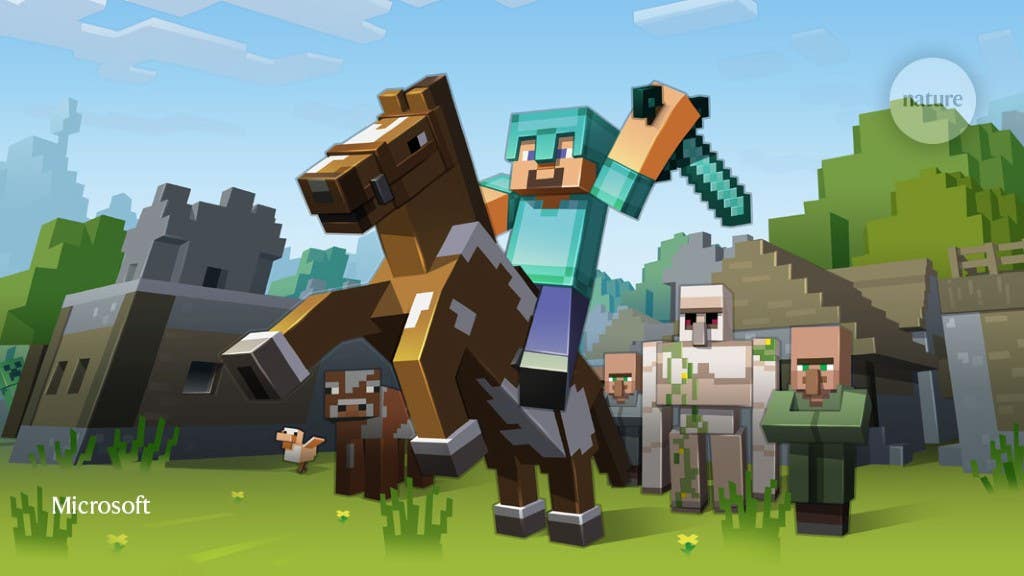Block by block: Researchers use Minecraft to advance artificial intelligence
Research to investigate next-generation artificial intelligence (AI) skills and perhaps make Steve, the Minecraft avatar, a little smarter.

[August 11, 2021: Penn State]
A Minecraft agent, operated by computer science master's student Ayushi Agrawal, explores a rainy environment. Researchers plan to test next-generation artificial intelligence skills within the game. (Credit: Screenshot provided by Ayushi Agrawal)
Steve may be able to saw wood, make tools, explore caves or dig for precious stones, but the Minecraft avatar cannot understand that each of these steps build to the ultimate goal of obtaining diamonds.
Alan Wagner, assistant professor of aerospace engineering at Penn State, and Sarah Rajtmajer, assistant professor of information sciences and technology, recently received a $900,000 grant from the United States Air Force Office of Scientific Research to investigate next-generation artificial intelligence (AI) skills and perhaps make Steve a little smarter.
The suggestion that people create abstract mental representations to plan for future events and solve multi-step tasks is identified in the literature as the Construal Level Theory, according to Wagner. People think about future events, consciously or unconsciously, using memories and experiences to generate a plan for a future situation.
Wagner and Rajtmajer plan to create AI agents that can mirror the human ability to plan for future events, and then use the video game Minecraft as a tool to test the new software.
“We will create an app that will be able to direct agents to complete certain complex tasks, and then integrate that app into Minecraft to run tests on the software,” Wagner said. “The agent that we create, in this case a Minecraft avatar, will be able to think in abstractions, or in the past, present and future, to solve problems.”
Minecraft, owned by Microsoft and released in 2011, regularly hosts “challenges,” where AI creators compete to solve a problem on the game, such as mining a diamond. That challenge is one scenario Wagner and Rajtmajer will test with the new AI software.
To create the software, Wagner’s former graduate student, Ali Ayub, developed a clustering technique for creating different levels of AI abstract thinking. He named the technique centrally based concept learning, or CBCL.
“The hope is to use CBCL as a tool to allow us to create these abstractions and use them in a variety of ways in the game,” Wagner said. “Minecraft has different types of wood, rocks or animals, for example, and you can tie them into the AI planning process and allow the agent to pick the thing it needs to solve a particular problem.”
If they are successful, according to Wagner, the AI software could contribute to advances in robotics, logistics management, solving problems for pilots in the air, building structures in space and transforming drone flight.
“I think this research has the opportunity to address a longstanding and fundamental challenge in agent-based modeling and behavioral game theory,” Rajtmajer said.
“Current models of human social behavior are too simple and homogeneous to be applied to real-world behaviors. This work takes an important step toward representing elements of reasoning and social planning in AI.”
Like these kind of feel good stories? Get the Brighter Side of News' newsletter.
Tags: #New_Innovations, #AI, #Software, #Minecraft, #Robotics, #The_Brighter_Side_of_News
Joshua Shavit
Science & Technology Writer | AI and Robotics Reporter
Joshua Shavit is a Los Angeles-based science and technology writer with a passion for exploring the breakthroughs shaping the future. As a contributor to The Brighter Side of News, he focuses on positive and transformative advancements in AI, technology, physics, engineering, robotics and space science. Joshua is currently working towards a Bachelor of Science in Business Administration at the University of California, Berkeley. He combines his academic background with a talent for storytelling, making complex scientific discoveries engaging and accessible. His work highlights the innovators behind the ideas, bringing readers closer to the people driving progress.



